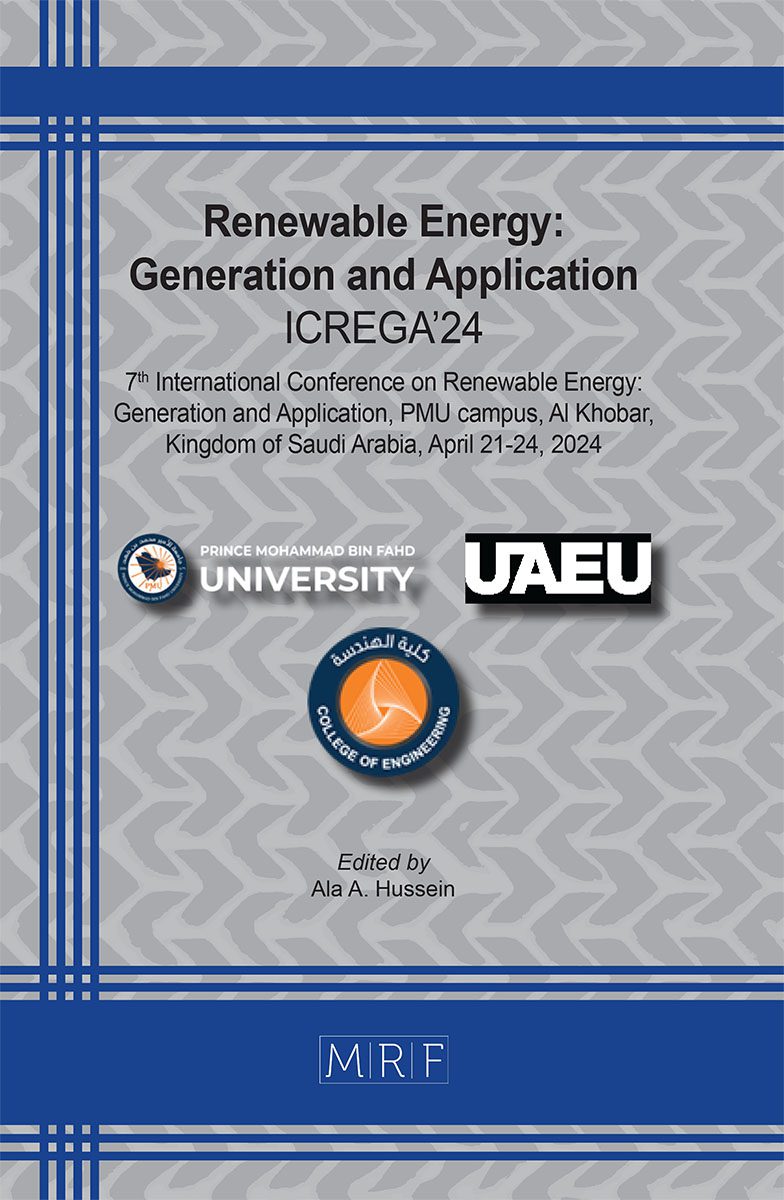–
On the performance assessment of King Faisal University grid-connected solar PV facility
Mounir BOUZGUENDA
download PDFAbstract. This paper evaluates the performance of the 9.8 kW grid-connected solar photovoltaic (PV) system mounted on the rooftop of the College of Engineering within the King Faisal University campus. The facility consists of four fields rated 2.45 kW each. Each field consists of ten 10 solar panels connected to a 3kW. The collected data include hourly and sub-hourly measurements of the radiation, ambient and module temperatures, AC and DC voltages, currents, and power outputs. Other measurements include cumulative produced energy and CO2 savings. The assessed parameters of the PV facility include daily, and monthly energy, final yield, efficiency, and module performance ratio (PR). Aggregate performance analysis results show that the station operated as planned. The annual radiation measured in 2017 reached 2449 kWh/m2 with a daily average of 6.710 kWh/m2. The annual energy production reached 16.047 MWh with an average of 43.964 kWh/day. The system efficiency and capacity factor are 11.22% and 17.25%, respectively.
Keywords
Energy Performance Index, Array Yield, Final Yield, Performance Ratio, Capacity Factor, System Efficiency, KSA 2030 Vision
Published online 7/15/2024, 8 pages
Copyright © 2024 by the author(s)
Published under license by Materials Research Forum LLC., Millersville PA, USA
Citation: Mounir BOUZGUENDA, On the performance assessment of King Faisal University grid-connected solar PV facility, Materials Research Proceedings, Vol. 43, pp 277-284, 2024
DOI: https://doi.org/10.21741/9781644903216-36
The article was published as article 36 of the book Renewable Energy: Generation and Application
![]() Content from this work may be used under the terms of the Creative Commons Attribution 3.0 license. Any further distribution of this work must maintain attribution to the author(s) and the title of the work, journal citation and DOI.
Content from this work may be used under the terms of the Creative Commons Attribution 3.0 license. Any further distribution of this work must maintain attribution to the author(s) and the title of the work, journal citation and DOI.
References
[1] Maennel, Alexander, and Hyun-Goo Kim. “Comparison of greenhouse gas reduction potential through renewable energy transition in South Korea and Germany.” Energies 11.1 (2018): 206. https://doi.org/10.3390/en11010206
[2] GlobalData’s Saudi Arabia Solar PV Analysis: Market Outlook to 2035 report
[3] AlOtaibi, Z.S., Khonkar, H.I., AlAmoudi, A.O. et al., “Current status and future perspectives for localizing the solar photovoltaic industry in the Kingdom of Saudi Arabia”, Energy Transit 4, 1-9 (2020). https://doi.org/10.1007/s41825-019-00020-y
[4] Vikrant Sharma, S.S. Chandel, “Energy Performance analysis of a 190 kWp grid interactive solar photovoltaic power plant in India”, Energy, Volume 55, 15 June 2013, Pages 476-485? https://doi.org/10.1016/j.energy.2013.03.075
[5] Ayompe, et al., “Measured performance of a 1.72 kW rooftop grid connected photovoltaic system in Ireland”, Energy Convers. Management 52, ??816-825. https://doi.org/10.1016/j.enconman.2010.08.007
[6] Emmanuel Kymakis et. Al., “Performance analysis of a grid connected photovoltaic park on the island of Crete”, Energy Conversion and Management, Volume 50, Issue 3, March 2009, Pages 433-438. https://doi.org/10.1016/j.enconman.2008.12.009
[7] Ahmed Bilal et al. “Solar Energy Resource Analysis and Evaluation of Photovoltaic System Performance in Various Regions of Saudi Arabia”, Sustainability 2018, 10, 1129. https://doi.org/10.3390/su10041129
[8] Nibras et al., “Performance Analyses of 15 kW Grid-Tied Photovoltaic Solar System Type under Baghdad city climate”, Journal of Engineering 26(4):21-32, March 2020. https://doi.org/10.31026/j.eng.2020.04.02
[9] A.H. Al-Badi et al., “Economic perspective of PV electricity in Oman”, Energy, Volume 36, Issue 1, January 2011, Pages 226-232. https://doi.org/10.1016/j.energy.2010.10.047
[10] Cristobal et al., “Self-consumption for energy communities in Spain: A regional analysis under the new legal framework”, Energy Policy, March 2021, 150(4):112144. https://doi.org/10.1016/j.enpol.2021.112144
[11] Today in Energy, “Southwestern states have better solar resources and higher solar PV capacity, factors”, https://www.eia.gov/todayinenergy/detail.php?id=39832












